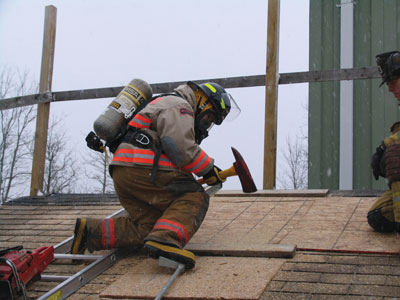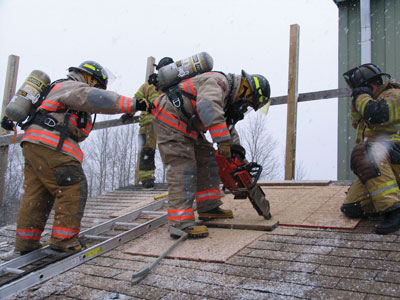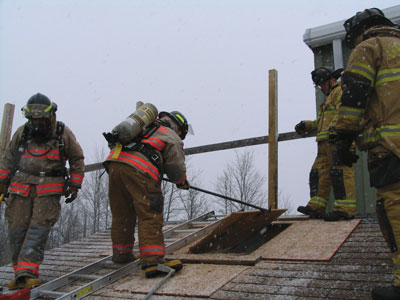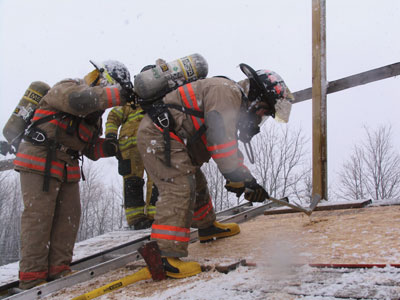
Features
Structural
Training
Back to Basics: May 2011
Vertical ventilation is an effective way to remove the products of combustion quickly and efficiently. Going to the roof to make a vertical vent is dangerous but the payoff is the quick removal of hot gases and smoke, and the injection of fresh air. Firefighters can make many types of vents; the roof style will help firefighters decide which type of vent is appropriate.
April 28, 2011
By Mark van der Feyst
Vertical ventilation is an effective way to remove the products of combustion quickly and efficiently. Going to the roof to make a vertical vent is dangerous but the payoff is the quick removal of hot gases and smoke, and the injection of fresh air. Firefighters can make many types of vents; the roof style will help firefighters decide which type of vent is appropriate. The louvred or hinged cut is the most common type of vent; it uses the nailed sheeting resting on the roof trusses as a hinge point for the vent.
 |
|
| Photo 1: Once in position, the firefighter can make a support step on the roof, using the Halligan bar or the pick-head axe. | |
 |
|
| Photo 2: Notice how the chainsaw is not in line with the firefighter’s foot – this is standard practice to avoid accidental injury. | |
 |
|
| Photo 3: The second firefighter can take the roof hook or pike pole and hinge the vent. | |
 |
|
| Photo 4: The Halligan bar is being used to cut the roof hole. The wider surface of the back of the adz end of the Halligan allows for better cutting and prevents binding in the roof. Photos by Crystal Johns |
As discussed in the March issue, firefighters cutting a vent need to use the roof ladder to provide adequate slip protection and to evenly distribute weight. The roof ladder serves as a staging area for the tools needed for the task. Placing tools on the roof ladder ensures that firefighters can locate them easily and quickly. Once the roof ladder is in place, ensure that the roof hooks are snug against the peak of the roof and will not slip off when the ladder is stepped on.
Before stepping off the ground ladder and onto the roof ladder, it is vital that the firefighters sound the roof with a hand tool to ensure that it can support weight. A weakened roof (one that feels spongy or sounds hollow) should be avoided. Use some force when sounding the roof – little taps will tell you nothing about the condition of the roof.
Once you are on the roof, stage all your equipment on the ladder. As you make your way up the roof ladder and into position to make the vent, keep sounding the roof with the hand tool. Once in position, one firefighter can make a support step on the roof, using the Halligan bar or the pick-head axe as shown in photo 1. This allows the firefighter to step off the roof ladder to make cuts without compromising safety. The hand tool spiked into the roof prevents your foot from slipping.
One firefighter can now take a roof hook or a pike pole and start sounding the joists. The edge of the pike pole or roof hook can be used to scribe lines to mark out the locations of the roof joists. This allows the firefighter with the chainsaw to avoid cutting through the roof joist as he is making the vent (some chainsaws have depth gauges to help you avoid cutting through the roof joists). Cutting the joists will weaken the roof and increase the possibility of a partial roof collapse.
Once the joist lines are marked, the firefighter with the chainsaw can begin to cut. Four cuts need to be made for a louvred vent. The first cut is the farthest cut away from you, parallel with the roof joists. This cut should be in the middle of two joists. Start the cuts away from you (see photo 2) and work back toward the roof ladder so you aren’t trapping yourself or standing on a weakened roof with heavy smoke or fire coming out. In photo 2, notice how the chainsaw is not in line with the firefighter’s foot – this is standard practice to avoid accidental injury. Always keep your feet out of the cutting path of the chainsaw. After you have made the cut and the chainsaw has been pulled out of the roof, roll your hand forward to engage the chain break. This prevents the chain from spinning freely and cutting or catching someone’s gear or body part. When setting up for the next cut, place the chainsaw in the proper position on the roof, then disengage the chain break.
The second firefighter must help the cutting firefighter navigate his way through the cut and warn him if he’s too close to the edge. The guiding firefighter must look at the surrounding area for changes in conditions. He can also communicate with the cutting firefighter by tapping him to get his attention or to have him stop cutting. Verbal communication does not work, especially when a chainsaw is being used at full throttle.
The rest of the cuts can be made in any order as long as the last cut is parallel with the roof ladder. At this point, the four sides should be cut and the cutting firefighter should have both feet back on the roof ladder. Be sure to intersect the cuts at each corner well beyond the cut lines to produce a cross at each corner. This creates a free-moving louvre and prevents catching one of the corners because it was not cut through all the way.
The second firefighter can now take the roof hook or pike pole and hinge the vent, as seen in photo 3. Once the hole is hinged on its axis, the ceiling below needs to be removed to allow any smoke and hot gases to exit. Start plunging the roof hook or pike pole at the farthest point away and work your way back to the roof ladder. You do not want to be trapped between the roof ladder and the fire as smoke and heat start to pour from the hole. Once the hole has been made and the ceiling below has been punctured all the way through, it is time to get off the roof.
If the chainsaw malfunctions on the roof, hand tools are there to allow you to complete the task. The axe is the best tool for this, but it can create some problems, as the blade will bind with the roof material as you chop your way through. To alleviate this problem, you can use your hand tools in an unorthodox manner. As shown in photo 4, the Halligan bar is being used to cut the roof hole. The wider surface of the back of the adz end of the Halligan allows for better cutting and prevents binding in the roof. The same is true for a flat-head axe. The back of the axe will cut better and more quickly than the blade part. The drawback is that the axe blade is facing you as you are cutting. Take caution with this and control your swings.
Mark van der Feyst is a 12-year veteran of the fire service who currently works for the City of Woodstock Fire Department in Ontario. E-mail him at Mark@FireStarTraining.com
Print this page